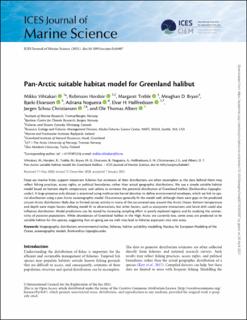| dc.contributor.author | Vihtakari, Mikko | |
| dc.contributor.author | Hordoir, Robinson | |
| dc.contributor.author | Treble, Margret A | |
| dc.contributor.author | Bryan, Meaghan D. | |
| dc.contributor.author | Elvarsson, Bjarki | |
| dc.contributor.author | Nogueira, Adriana | |
| dc.contributor.author | Hallfredsson, Elvar H. | |
| dc.contributor.author | Christiansen, Jørgen Schou | |
| dc.contributor.author | Albert, Ole Thomas | |
| dc.date.accessioned | 2021-06-03T09:42:10Z | |
| dc.date.available | 2021-06-03T09:42:10Z | |
| dc.date.created | 2021-03-19T09:40:27Z | |
| dc.date.issued | 2021 | |
| dc.identifier.citation | ICES Journal of Marine Science. 2021, . | en_US |
| dc.identifier.issn | 1054-3139 | |
| dc.identifier.uri | https://hdl.handle.net/11250/2757531 | |
| dc.description.abstract | Deep-sea marine fishes support important fisheries but estimates of their distributions are often incomplete as the data behind them may reflect fishing practices, access rights, or political boundaries, rather than actual geographic distributions. We use a simple suitable habitat model based on bottom depth, temperature, and salinity to estimate the potential distribution of Greenland halibut (Reinhardtius hippoglossoides). A large presence-only dataset is examined using multivariate kernel densities to define environmental envelopes, which we link to spatial distribution using a pan-Arctic oceanographic model. Occurrences generally fit the model well, although there were gaps in the predicted circum-Arctic distribution likely due to limited survey activity in many of the ice-covered seas around the Arctic Ocean. Bottom temperature and depth were major factors defining model fit to observations, but other factors, such as ecosystem interactions and larval drift could also influence distribution. Model predictions can be tested by increasing sampling effort in poorly explored regions and by studying the connectivity of putative populations. While abundances of Greenland halibut in the High Arctic are currently low, some areas are predicted to be suitable habitat for this species, suggesting that on-going sea-ice melt may lead to fisheries expansion into new areas. | en_US |
| dc.language.iso | eng | en_US |
| dc.title | Pan-Arctic suitable habitat model for Greenland halibut | en_US |
| dc.type | Peer reviewed | en_US |
| dc.type | Journal article | en_US |
| dc.description.version | publishedVersion | en_US |
| dc.source.pagenumber | 17 | en_US |
| dc.source.journal | ICES Journal of Marine Science | en_US |
| dc.identifier.doi | https://doi.org/10.1093/icesjms/fsab007 | |
| dc.identifier.cristin | 1899201 | |
| cristin.ispublished | true | |
| cristin.fulltext | original | |
| cristin.qualitycode | 1 | |
